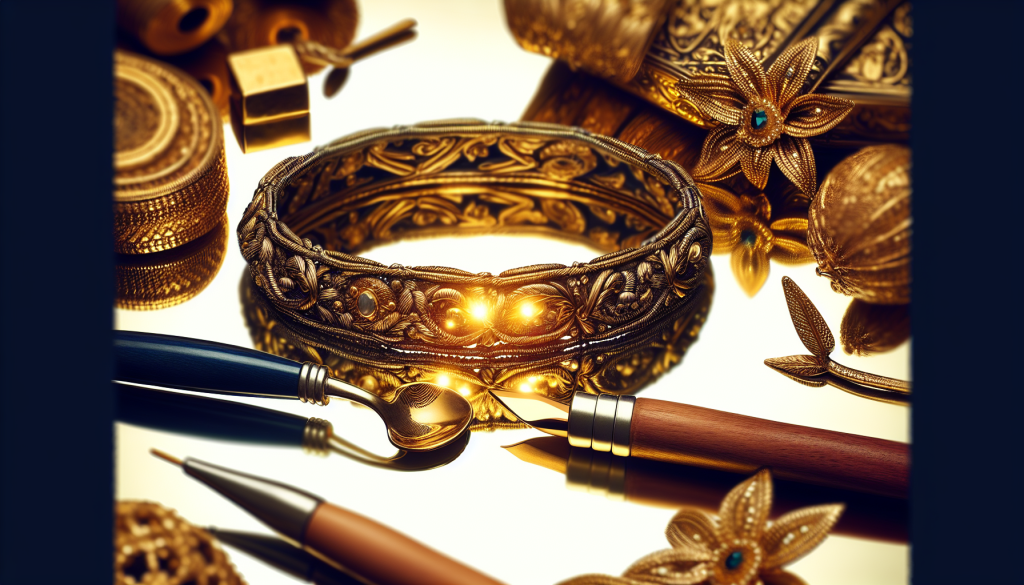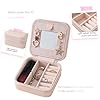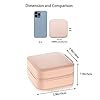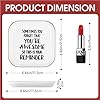You’ll be amazed to discover that the term “solid gold” doesn’t mean pure gold! In fact, solid gold jewelry is typically made with a mixture of gold and other metals to increase its durability. But how much gold is actually present in these pieces that claim to be “solid gold”? This article will unveil the truth behind the composition of solid gold and shed light on the various karat measurements used to determine its purity. Prepare to be enlightened and learn the fascinating world of gold!
KElofoN Travel jewelry case Travel jewelry box Travel Jewelry Organizer Small box Gift for Girls Women with Mirror(Pink)
$8.98 (as of December 19, 2025 20:26 GMT +00:00 - More infoProduct prices and availability are accurate as of the date/time indicated and are subject to change. Any price and availability information displayed on [relevant Amazon Site(s), as applicable] at the time of purchase will apply to the purchase of this product.)VOMNA Mini Jewelry Travel Case,Small Jewelry Box,Traveling Jewelry Organizer,Portable Jewellery Storage Holder for Rings Earrings Necklace Bracelet Bangle for Girls Women(Pink - 1 pack)
$4.98 (as of December 19, 2025 20:26 GMT +00:00 - More infoProduct prices and availability are accurate as of the date/time indicated and are subject to change. Any price and availability information displayed on [relevant Amazon Site(s), as applicable] at the time of purchase will apply to the purchase of this product.)Homde Synthetic Leather Huge Jewelry Box Mirrored Watch Organizer Necklace Ring Earring Storage Lockable Gift Case (White + Gold)
$49.99 (as of December 19, 2025 19:38 GMT +00:00 - More infoProduct prices and availability are accurate as of the date/time indicated and are subject to change. Any price and availability information displayed on [relevant Amazon Site(s), as applicable] at the time of purchase will apply to the purchase of this product.)PUDDING CABIN Inspirational Gifts for Women Ring Dish You're Awesome So This is Your Remind Birthday Gifts for Women Unique, Friends Gifts for Her Mom Sister Coworker
$9.97 (as of December 19, 2025 21:01 GMT +00:00 - More infoProduct prices and availability are accurate as of the date/time indicated and are subject to change. Any price and availability information displayed on [relevant Amazon Site(s), as applicable] at the time of purchase will apply to the purchase of this product.)Hatori Travel Jewelry Box, PU Leather Small Jewelry Organizer for Women Girls, Portable Mini Travel Case Display Storage Holder Boxes for Stud Earrings, Rings, Necklaces, Bracelets.
41% Off
What is Solid Gold?
Solid gold refers to a type of gold that is pure and free from any other metals or impurities. It is considered to be one of the most valuable and sought-after forms of gold. Solid gold is often used for jewelry and investment purposes due to its durability, beauty, and rarity. To understand the concept of solid gold better, let’s dive deeper into its definition and composition.
Definition of Solid Gold
Solid gold is a term used to describe gold that is 24 karats, or 100% pure. It contains no other metals or alloys mixed with the gold. In its purest form, solid gold is naturally a bright yellow color. However, it can also be alloyed with other metals to produce different colors and variations.
Composition of Solid Gold
Solid gold is composed solely of gold atoms. It is a dense and heavy metal that is highly malleable and ductile. Its atomic symbol is Au, and it has an atomic number of 79. Solid gold has a distinct shine and luster that sets it apart from other metals. Its chemical properties make it resistant to tarnish and corrosion, making it an excellent choice for jewelry.
Purity of Solid Gold
Understanding the purity of solid gold is vital when buying or investing in gold. The purity level of gold is measured by its karat weight, which indicates the ratio of pure gold to other metals or alloys mixed with it. Let’s explore the concept of gold purity further.
Understanding Gold Purity
Gold purity refers to the amount of gold present in an object or material. It is typically measured in karats (kt) or parts per thousand (ppt). The higher the karat weight, the purer the gold. For example, 24 karat gold is considered pure gold, while 18 karat gold contains 75% gold.
Different Purity Standards
Different countries have varying purity standards for gold. In the United States, the Federal Trade Commission (FTC) determines the standards for marking gold jewelry. The most common purity standards for gold jewelry in the US include 10kt, 14kt, 18kt, and 24kt. Each standard represents a different percentage of gold content.
Common Purity Levels of Solid Gold
Solid gold is typically available in 24 karat and 22 karat purity levels. Pure, solid gold is 24 karats, meaning it is 99.9% pure gold. However, 24 karat gold is relatively soft and may not be suitable for certain types of jewelry. Consequently, 22 karat gold, which contains 92% gold and 8% other metals, is another popular choice for jewelry making.
Determining the Gold Content
There are several methods to determine the gold content in a piece of jewelry or any other form of solid gold. Precise testing is crucial to establish the true value and purity of the gold. Let’s explore some of the commonly used testing methods.
Assay Testing
Assay testing is a trusted and reliable method to determine the gold content in solid gold. It involves taking a small sample of the gold and subjecting it to a series of chemical reactions and tests. The result is a precise determination of the gold content, expressed in karats.
X-Ray Fluorescence Testing
X-ray fluorescence (XRF) testing is a non-destructive method that uses X-rays to analyze the composition of solid gold. It can determine the presence and percentage of different elements present in the sample, including gold. XRF testing is quick and accurate, making it a popular choice for assessing gold purity.
Fire Assay Testing
Fire assay testing is one of the oldest and most accurate methods for determining gold content. It involves melting the gold sample and separating the gold from other impurities. By measuring the weight of the resulting pure gold, the gold content can be determined.
Specific Gravity Testing
Specific gravity testing measures the density of solid gold to determine its purity level. It compares the weight of the gold sample to the weight of an equal volume of water. Pure gold has a specific gravity of 19.32, and any deviation from this value indicates the presence of impurities.
Factors Affecting Gold Content
Various factors can affect the gold content in solid gold, including alloys, impurities, karat weight, jewelry making techniques, and recycled gold. Let’s explore these factors in more detail.
Alloys and Impurities
When creating jewelry, gold is often mixed with other metals to enhance its durability or change its color. These metals, known as alloys, lower the overall gold content in the final product. Impurities, such as dirt or other metals inadvertently mixed with the gold during the mining process, can also lower the gold content.
Karat Weight
The karat weight of gold determines its purity level. The higher the karat weight, the more pure the gold. Lower karat weights indicate a higher percentage of alloys mixed with the gold. Different karat weights are often used for specific types of jewelry or purposes.
Jewelry Making Techniques
Certain jewelry making techniques, such as soldering or casting, may introduce additional metals into the gold, compromising its purity. It is essential to consider how the jewelry is made when assessing the gold content.
Recycled Gold
Recycled gold, also known as reclaimed gold, refers to gold that has undergone a refining process to remove impurities and alloys. While recycled gold can have a lower gold content, it is a sustainable option and helps reduce the environmental impact of gold mining.

Weight vs. Value
When it comes to determining the value of solid gold, weight plays a significant role. The weight of gold is measured using different units, and understanding how weight translates into value is crucial.
Weight Measurement for Gold
The most common unit of measurement for gold weight is the troy ounce (ozt), which is slightly heavier than a standard ounce. Other units, such as grams (g) and kilograms (kg), are also used. Jewelers typically use smaller units, such as pennyweights (dwt) or grams, to measure gold.
Calculating the Value of Solid Gold
To calculate the value of solid gold, you need to know the weight, purity, and the current market price of gold. The value can be determined by multiplying the weight of the gold (in troy ounces or grams) by the purity (in decimals) and multiplying the result by the current price of gold per troy ounce or gram.
Gold Hallmarks
Gold hallmarks are markings or stamps on gold jewelry and other gold items that indicate the purity and authenticity of the gold. Understanding these hallmarks is essential when buying or selling gold.
Importance of Gold Hallmarks
Gold hallmarks serve as a guarantee of the gold’s purity and quality. They provide assurance that the gold item meets the industry standards and facilitates accurate pricing and identification.
Understanding Hallmark Symbols
Hallmark symbols vary depending on the country and can include initials, numbers, or specific symbols that represent the purity of the gold. For example, a common hallmark in the United States is “14k,” indicating 14 karat gold.
Hallmarking Systems by Country
Different countries have their hallmarking systems, each with its unique set of symbols and regulations. Some well-known hallmarking systems include those in the United States (Federal Trade Commission guidelines), the United Kingdom (Assay Offices), and Switzerland (Poinçons de Maître system).

Gold Testing at Home
While it is recommended to seek professional testing for accurate results, some home testing methods can provide a general indication of the gold content. Let’s explore a few common home testing methods.
Home Testing Kits
Home testing kits for gold are readily available and often include testing acids, test stones, and instructions. These kits can provide a basic assessment of gold purity but may not be as accurate as professional testing methods.
Acid Testing
Acid testing involves applying different acids to the gold sample and observing the reaction. Different acids are used for testing different purity levels of gold. For example, nitric acid is commonly used to test for the presence of lower carat gold.
Magnet Testing
Magnet testing involves using a magnet to determine if the gold is pure or contains other metals. Since gold is not magnetic, it should not be attracted to a magnet. If the gold is magnetized, it likely contains other metals.
Electronic Testing
Electronic gold testers use conductivity measurements to determine the purity of gold. These handheld devices are easy to use and can provide quick results. They work by measuring the flow of electricity through the gold sample.
Gold Vermeil and Gold Plating
Gold vermeil and gold plating are popular alternatives to solid gold. Understanding the differences between these options is essential when choosing gold jewelry.
Differences between Gold Vermeil and Solid Gold
Gold vermeil is a combination of sterling silver and gold plating. It features a thick layer of gold over a base of sterling silver, providing a more affordable option that closely resembles solid gold. Gold plating, on the other hand, involves a thin layer of gold electroplated onto a base metal.
Gold Plating Thickness
The thickness of gold plating can vary significantly. Higher quality gold-plated items tend to have a thicker layer of gold, making them more durable and longer-lasting.
Care and Maintenance
Both gold vermeil and gold-plated items require proper care and maintenance to preserve their appearance and quality. Avoid exposing them to harsh chemicals, abrasive materials, and excessive moisture to prevent the gold layer from wearing off.

Investing in Solid Gold
Investing in solid gold can be a wise financial decision. When considering investing in gold, there are several factors to consider.
Factors to Consider
Factors to consider when investing in solid gold include the current market price of gold, the purity of the gold, storage options, and market fluctuations. It is essential to stay informed and consult with experts to make informed investment decisions.
Gold Bullion
Gold bullion refers to gold bars or ingots that are typically 99.5% pure gold. Investing in gold bullion provides a tangible asset that is easily tradable and highly liquid. Gold bullion can be purchased in different weights and sizes, offering flexibility to investors.
Gold ETFs
Gold exchange-traded funds (ETFs) offer an alternative way to invest in gold without physically owning the gold. ETFs are investment funds traded on stock exchanges that aim to track the performance of gold prices. They provide investors with exposure to gold price movements, making them a convenient investment option.
Collectible Gold Coins
Collectible gold coins offer a unique investment opportunity, combining the value of gold with the rarity and historical significance of the coins. These coins often have numismatic value in addition to their gold content, making them sought-after by collectors and investors alike.
Conclusion
Solid gold is a precious and highly sought-after form of gold due to its purity and value. Understanding the purity of solid gold, determining its gold content, and considering the various factors that affect gold value are crucial when buying or investing in solid gold. Whether you’re buying jewelry or considering gold as an investment, being knowledgeable about solid gold will help you make informed decisions and appreciate the beauty and worth of this precious metal.































